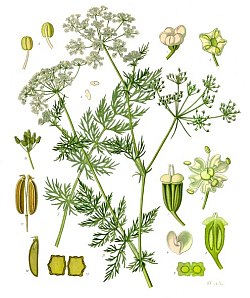Caraway History: Name Origins.
(Carum carui, Linn.)

The origins of the name caraway come from the Arabic al-karwiya seeds; which some presume is the origin of the Latin word carvi and from Caria, where caraway may have first been used.
Early History of Caraway.
Two of our sources indicated that the history of caraway dates back to the Stone Age. Caraway seeds were discovered in the refuse areas of prehistoric communities in southern Europe. Those finds are believed to indicate that the plant was a part of early man’s daily life.
The roots of caraway plants were said to warm and stimulate a cold, languid stomach. It was combined with milk to make a bread which formed the chara of Julius Caesar that was eaten by the soldiers of Valerius.
Dioscorides, an ancient Greek physician, pharmacologist and botanist at the time of Nero, advised using caraway oil for ‘pale-faced girls’. During my research on the history of caraway, I couldn’t find a reference that explains what ailment he was referring to.
Caraway Seed Folklore.
In German folklore, parents placed a dish of caraway seeds beneath their children’s beds to protect them from witches. The belief was that that any object containing caraway could not be stolen.
The history of caraway also has a romantic side. Caraway was once used as an aide in preventing fickleness and was used in love potions. Caraway seeds were also added to chicken feed in hopes of keeping them from wandering off and is still sometimes given to homing pigeons.
The Shakespearean and Victorian Connection.
During Elizabethan times caraway was used as a condiment and is mentioned in Shakespeare’s Henry IV Part Two. For a period caraway became unpopular but it saw a revival during the reign of Queen Victoria when all things German became fashionable. (Caraway is often used in sauerkraut, sausages, dumplings, and a number of other German dishes.)
Medicinal Uses of Caraway.
Caraway is related to dill, fennel and anise and has been thought to have many of the same medicinal properties – an antiseptic, antispasmodic, carminative, and digestive. It’s been used to stimulate milk production in mothers as well as treat infant colic and is often used to flavor children’s medicines.
Modern Uses.
Today, caraway is still recommended as a treatment for flatulence. Some parts of the world serve caraway seeds after meals much like an after-dinner mint.
As a culinary herb, caraway is frequently used in German and Austrian cooking as a seasoning for cheese, dumplings, port, goose and sausages. It continues to be used for sauerkraut as well as breads, cakes, and sweetmeats.
Young caraway shoots are used with salads and many eat boiled roots like a vegetable.
Additional Caraway Information.
Our Herb Garden also has guides on Growing Caraway and Caraway Companion Planting.